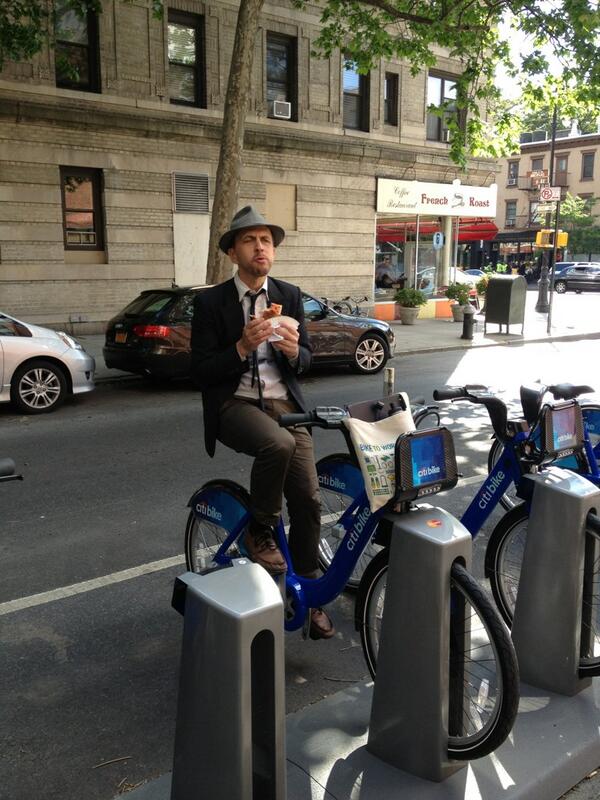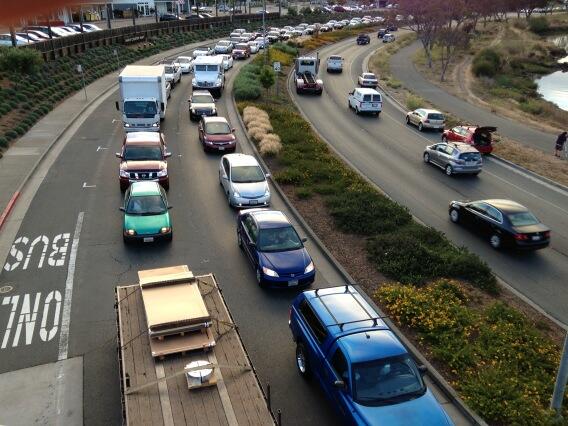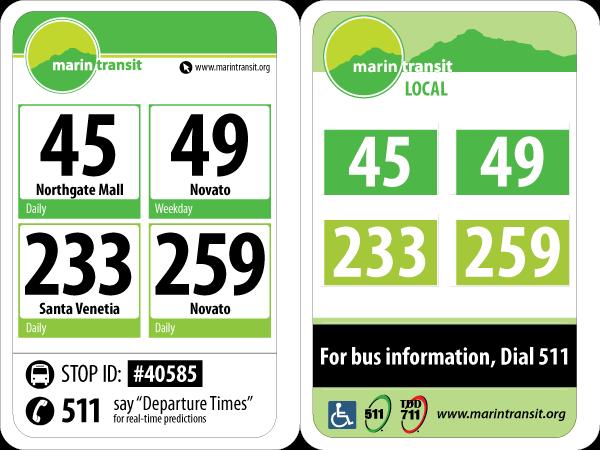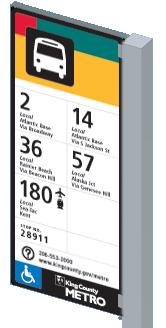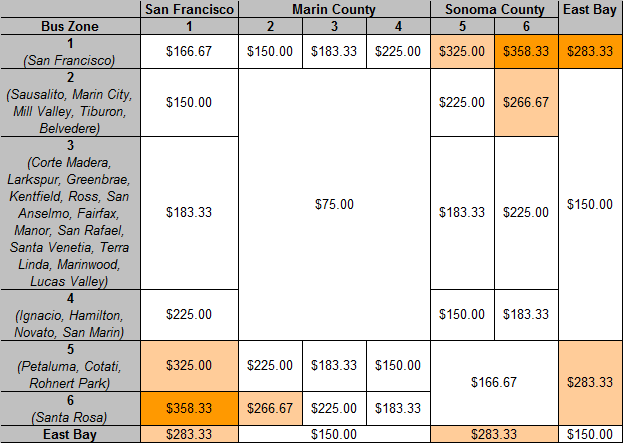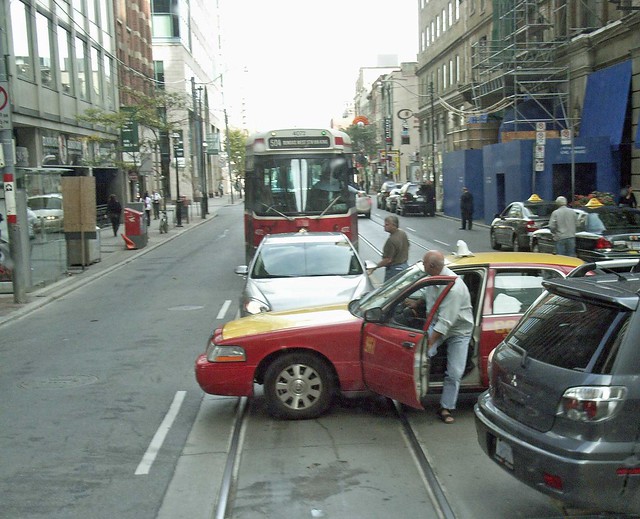In 2010, Streetsblog posted this response from Donald Shoup, a professor of urban policy at UCLA to a blog post by Randal O'Toole, a Cato scholar. Here, Shoup addresses that post's arguments regarding the high-cost of free parking. Given that the Cato scholar will be speaking at a debate in Marin at the end of this month, it will be worth our time to explore some of the ways he has things wrong whether through error, incuriosity, or obfuscation.
O'Toole has written extensively on subjects beyond parking, including mass transit and urban patterns. We'll explore those in time.
A fair warning: Shoup's response is very long, so there is a jump. The rest, from here, is Streetsblog, Shoup, and O'Toole.

Dear Randal,
I would like to comment on your August 16 post on the Cato@Liberty blog about “Free Markets for Free Parking.”
You were responding to Tyler Cowen’s article in the New York Times, “Free Parking Comes at a Price,” in which Tyler explained some of the ideas in my book, The High Cost of Free Parking.In commenting on Tyler’s article, you made several mistakes in describing my ideas and proposals. I will explain these mistakes, and if you agree with the explanations I hope you will post corrections on Cato@Liberty.
Before I examine your misunderstanding of what I have written, I will first summarize the three basic parking reforms I recommend in The High Cost of Free Parking: (1) remove off-street parking requirements, (2) charge market prices for on-street parking to achieve about an 85-percent occupancy rate for curb spaces, and (3) return the resulting revenue to pay for public improvements in the metered neighborhoods.
I will quote ten extracts from your post, and comment on each of them.
1.
"Shoup’s work is biased by his residency in Los Angeles, the nation’s densest urban area. One way L.A. copes with that density is by requiring builders of offices, shopping malls, and multi-family residences to provide parking. Shoup assumes that every municipality in the country has such parking requirements, even though many do not."
Does the Antiplanner, who is “dedicated to the sunset of government planning,” really believe that government planners know exactly how many parking spaces to require for every economic activity at every site in every city?
Even Houston, which does not have zoning, has minimum parking requirements, and they resemble the parking requirements in almost every other city in the United States. Houston requires 1.25 parking spaces for each efficiency apartment in an apartment house, for example, and 1.333 parking spaces for each one-bedroom apartment. Here is the link to the minimum parking requirements in Houston’s municipal code.
Does the Antiplanner, who is “dedicated to the sunset of government planning,” really believe that government planners know exactly how many parking spaces to require for every economic activity at every site in every city, no matter how much the required parking spaces may cost and no matter how little drivers may be willing to pay to use them? Does the Antiplanner really support Houston’s minimum parking requirement of 1.333 spaces for each one-bedroom apartment because he believes that Houston’s government planners can accurately predict the “need” for parking at every apartment to one-thousandth of a parking space?
Since you say that many cities do not have minimum parking requirements, can you provide a list of some of these cities?
2.
“Shoup assumes that . . . without such requirements there would be less free parking. This last assumption is extremely unlikely, as entrepreneurs everywhere know that (outside of New York City) 90 percent of all urban travel is by car, and businesses that don’t offer parking are going to lose customers to ones that do.”
Removing a minimum parking requirement means that a city will never force developers to supply more parking spaces than are profitable, but developers would be free to provide as many parking spaces as they like. If developers did always voluntarily supply at least as many parking spaces as cities now require, the minimum parking requirements would be unnecessary. The only research I have seen found that developers usually do not provide more parking spaces than cities require (pp. 78–84 of The High Cost of Free Parking). Recent econometric research also strongly suggests that minimum parking requirements force developers to provide more parking spaces than they would voluntarily provide in a free market [PDF].
3.
“Shoup portrays such free parking as a ‘subsidy’ because not all people drive and so the ones who don’t drive end up subsidizing the ones who do. But any business offers a variety of services to its customers and employees, and no one frets about subsidies just because they don’t take advantage of every single service. How often do you actually swim in the swimming pools or work out in the exercise rooms of the hotels you stay at?”
Every person plays many different roles in life -- tenant, homeowner, worker, consumer, investor, and motorist. With bundled parking, we pay for parking in all these roles except, usually, as motorists.
You use swimming pools and exercise rooms as examples of bundled services at hotels, but cities do not require hotels to provide swimming pools and exercise rooms. Suppose, however, cities did require all hotels to provide swimming pools and exercise rooms, perhaps as a part of a public health campaign. Cities could require all these swimming pools and exercise rooms to be of at least a minimum size related to the number of rooms or gross floor area in a hotel. For example, cities could require every hotel to provide a swimming pool with at least 2,500 gallons of water per guest room. If cities did have minimum pool requirements, I expect that almost all hotels would bundle the use of the pools into the room rents. Would you then say that all these swimming pools are the result of free choices made in a free market? Would you say the market had demonstrated that hotel guests like to swim? Would you say the minimum pool requirements do not subsidize swimmers at the expense of nonswimmers? But let’s get back to parking; even swimming pools have parking requirements, and here is the minimum parking requirement for swimming pools in one city: 1 parking space for every 2,500 gallons of water in a swimming pool (Table 3-4 in The High Cost of Free Parking).
Every person plays many different roles in life -- tenant, homeowner, worker, consumer, investor, and motorist. With bundled parking, we pay for parking in all these roles except, usually, as motorists. Because we pay for parking indirectly, its cost does not deter us from driving. Because off-street parking requirements force up the supply of parking spaces, they “externalize” the cost of parking by shifting it to everyone but the parker. Only if we pay for parking directly does its cost affect our decisions whether to drive or not.
If cities require an ample supply of parking spaces for every building, this saves everyone the trouble of thinking about parking -- or its cost. Parking appears free because its cost is widely dispersed in slightly higher prices for everything else. Because we buy and use cars without thinking about the cost of parking, we congest traffic, waste fuel, and pollute the air more than we would if we each paid for our own parking. Everyone parks free at everyone else’s expense.
The issue is not simply whether parking is subsidized. Even without minimum parking requirements some firms would choose to offer free parking, just as some hotels offer swimming pools and some coffee shops offer wi-fi. The real issue is whether the government should mandate the parking supply.
When the US Census Bureau surveyed owners and managers of multifamily rental housing to learn which governmental regulations made their operations most difficult, parking requirements were cited more frequently than any other regulation except property taxes.
If a city like Houston will not allow any developer to build a one-bedroom apartment without also providing at least 1.333 parking spaces, is it any surprise that most landlords bundle the cost of parking into higher rents for housing? As a result, we have free parking and expensive housing. Cars are more affordable but housing is less affordable. When the US Census Bureau surveyed owners and managers of multifamily rental housing to learn which governmental regulations made their operations most difficult, parking requirements were cited more frequently than any other regulation except property taxes. (p. 141 in The High Cost of Free Parking).
Off-street parking requirements collectivize the cost of parking, because they allow everyone to park free at everyone else’s expense. American drivers park free at the end of 99 percent of all their automobile trips. If the cost of parking is hidden in the prices of other goods and services, no one can pay less for parking by using less of it. Off-street parking requirements thus change the way we build our cities, the way we travel, and how much energy we consume. All the required parking spaces spread the city out, and the greater travel distances make driving almost a necessity. Free parking also reduces the price of driving wherever we want to go, so the increased travel distances combined with the reduced price of driving make cars the obvious choice for most trips: 87 percent of all trips in the U.S. are now made in personal motor vehicles. (pp. 621–625 in The High Cost of Free Parking)
Off-street parking requirements produce the free parking that everyone wants, but ubiquitous free parking helps explain why American motor vehicles, by themselves, consume one-eighth of the world’s total oil production. We import two-thirds of this oil and we are paying for it with borrowed money. America’s extravagant consumption of imported oil to fuel our cars is not sustainable, economically or environmentally, and anything that is not sustainable must eventually stop.
4.
“Shoup also supposes (and Cowen accepts) that universal parking fees would greatly reduce the amount of driving people do. ‘Minimum parking requirements act like a fertility drug for cars,’ Cowen quotes Shoup as saying.”
Please cite any occasion on which I have recommended “universal parking fees.” I am not even sure what you mean by this term. If you mean all parking everywhere must have a substantial price at all times, I most certainly do not recommend that.
Figure 12-1 in The High Cost of Free Parking shows what I mean by the right price for parking, and the right price will often be zero. For example, if half of all the parking spaces at a suburban shopping mall are empty even when parking is free, it would not make sense to charge for parking. On the other hand, if all of the curb parking spaces in a congested business district are occupied and drivers are circling every block in search of a vacant curb space, the price of curb parking is too low. Here is the link to a video that shows how to set the right prices for curb parking.
5.
“Shoup claims that a single parking space costs, on average, 17 percent more than the cost of an average car, and as a result, the cost of parking greatly exceeds the value of all automobiles in the country. This is ridiculous... Even structured parking typically costs only about $10,000 a space.”
Table 7-3 in The High Cost of Free Parking shows that parking spaces built on the UCLA campus have cost, on average, 117 percent of the price of a new car in the years that the parking spaces were built, but I did not rely on this figure to calculate that the cost of parking exceeds the value of all automobiles in the country.
Using data on the capital and operating costs of parking lots and parking structures, I estimated that the subsidy for off-street parking in 2002 was between $127 billion and $374 billion, or between 1.2 percent and 3.6 percent of the gross domestic product. In comparison, in 2002 the federal government spent $231 billion for Medicare and $349 billion for national defense.
I relied on Census data to estimate that the cost of all parking spaces exceeds the value of all the automobiles in the country. The Department of Commerce estimated that the average value per vehicle was $5,507 in 1997. This average value may seem low, but the average age of all vehicles in 1995 was 8.3 years, and 62 percent of all vehicles were more than five years old. The depreciation of the older vehicles explains the low average value of $5,507 per vehicle. (Table 7-2 in The High Cost of Free Parking)
There are more parking spaces than vehicles because drivers must be able to park wherever they go, and many parking spaces are vacant much of the time. Cities typically require enough parking spaces to satisfy the peak demand for parking at every land use -- at home, work, school, restaurants, shopping centers, movie theaters, and hundreds of other places -- so that drivers can have convenient access to all addresses at all times. To see the result, think of what happens when almost all vehicles are parked at home in the middle of the night: almost all the spaces necessary to meet the peak demand for free parking at all other land uses are empty.
Cities require a specific number of parking spaces for every land use, but no city collects data on its total parking supply. No one knows the total number of parking spaces in the US, but the eminent land-use planner Victor Gruen estimated that every car has at least one parking space at home and three or four waiting elsewhere to serve the same car. More recently, Davis et al. (2010) used detailed aerial photographs to estimate the number of parking spaces in surface parking lots in Illinois, Indiana, Michigan, and Wisconsin. Parking lots were identified as paved surfaces with stripes painted on the surface or where more than three cars were parked in an organized fashion. Although the estimates did not include any on-street parking spaces, or any parking spaces in structures (other than the top floor if the structure has an open roof), or any residential parking spaces that are not in parking lots, the total area occupied by parking lots in the four states would cover about half the state of Rhode Island. In two cities in Indiana for which there were detailed observations, parking lots covered three times more land than parks.
Using this limited category of parking spaces (only the spaces in off-street surface parking lots), Davis et al. estimated that the parking supply ranged between 2.5 spaces per car in Indiana to 3 spaces per car in Michigan. Presumably, most cars also have one parking space at home, and many more parking spaces are on the streets and in structures.
To be extremely conservative, suppose there is one parking space at home for every car and only two additional parking spaces elsewhere (at work, school, supermarkets, and so on), for a total of three parking spaces per car. Let us also take your back-of-the-envelope estimate of $2,200 for the land and construction cost of a surface parking space, an extremely low value. The cost of the parking spaces available per car would be $6,600 (3 spaces per car x $2,200 per space). In this case, the per-car cost of parking exceeds the average value of a car ($5,507). If so, the total cost of the parking supply exceeds the total value of all cars. And this estimate does not include the cost of any parking spaces on the streets or in structures.
Please cite the source of your statement that “Even structured parking typically costs only about $10,000 a space.” The national average construction cost for an above-ground parking structure in 2010, according to Carl Walker Associates, is just over $16,000 per space (excluding land value). Underground parking structures are even more expensive. The most recent underground parking structure built at UCLA, for example, cost $31,500 per space (Table 6-1 in The High Cost of Free Parking). Yale is about to spend $20 million to build a 200-space underground parking structure for its new School of Management, which is a cost of $100,000 per space. Your rough estimates of $2,200 per space for surface parking and $10,000 per space for structured parking are probably far too low for parking lots and structures in many cities.
If the total cost of all parking spaces in the US exceeds the total value of all the cars parked in them, and if drivers park free for 99 percent of all their trips, the total subsidy for parking (the total cost of parking not paid for by drivers in their role as parkers) is huge. Using data on the capital and operating costs of parking lots and parking structures, I estimated that the subsidy for off-street parking in 2002 was between $127 billion and $374 billion, or between 1.2 percent and 3.6 percent of the gross domestic product. In comparison, in 2002 the federal government spent $231 billion for Medicare and $349 billion for national defense. (Chapter 7 in The High Cost of Free Parking)
Free curb parking may be the most costly subsidy that American cities provide for most of their citizens.
In addition, there is the subsidy for all the on-street parking spaces. Consider a 36-foot wide residential street with two 10-foot-wide travel lanes and two 8-foot-wide parking lanes: curb parking takes up 44 percent of the roadspace. Clearly, curb parking spaces account for a significant share of the total cost of roads, and an accurate estimate of the total subsidy for parking would take curb parking into account. The US Department of Commerce estimates that the value of roads is 36 percent of the value of all state and local public infrastructure (which also includes schools, sewers, water supply, residential buildings, equipment, hospitals, and parks). Because curb parking occupies a substantial share of road space, it must be a substantial share of all state and local public infrastructure. Drivers do not pay gasoline taxes while their cars are parked, except perhaps on the gasoline lost through evaporative emissions, which pollute the air. Since drivers do pay gasoline taxes while they are driving, curb spaces are subsidized much more than the travel lanes are. Free curb parking may be the most costly subsidy that American cities provide for most of their citizens. (p. 206 in The High Cost of Free Parking)
6.
“Strangely, one of the examples Cowen uses in his article is Manhattan, where (he claims) ‘streets are full of cars cruising around, looking for cheaper on-street parking, rather than pulling into a lot.’ Give me a break! I defy Cowen to find any free parking anywhere in Manhattan, where ownership of a single parking space can cost more than a median home in other parts of the country.”
I see that you retracted this no-free-parking-in-Manhattan claim in a later post.
Unfortunately, this retraction includes several new errors of fact.
7.
“Many streets in Manhattan offer free parking, albeit often with the caveat that you have to move your car from one side of the street to the other every night.”
New York does not require owners who park on the street to move their cars every night. It requires owners to move their cars twice a week so the city can sweep the streets under them. Most of the curb parking spaces in Manhattan are free, on some of the most valuable land on earth. As you say, a parking space in Manhattan can cost more than a house in other parts of the country, so these free curb spaces must provide an awesome subsidy for cars. And the competition for this awesome subsidy requires cruising to find a rare vacant space. This cruising for free parking wastes time and fuel, congests traffic, and pollutes the air.
A study of cruising in one 15-block business district in Los Angeles found that, over the course of a year, the search for underpriced curb parking created about 950,000 excess vehicle miles of travel—equivalent to 38 trips around the earth, or four trips to the moon. And here’s another inconvenient truth about underpriced curb parking: cruising those 950,000 miles wastes 47,000 gallons of gasoline and produces 730 tons of carbon dioxide. If all this happens in one small business district, imagine the cumulative effect of all cruising in throughout the United States. (Chapter 14 in The High Cost of Free Parking)
8.
“But this doesn’t change my main point, which is that it is one thing for Cowen to argue that cities should not price parking below market rates where there is a market for parking. I have no problem with this. But it is quite another thing to argue, as many urban planners following the Shoup model do, that private businesses should be required to charge for parking (or be limited in how much parking they are allowed to provide) in areas where the market rate for parking is zero.”
Please cite the source of a Shoup model that would require businesses to charge for parking. Opposing minimum parking requirements is very different from proposing minimum pricing requirements.
I have supported the policy of “parking cash out” whereby employers who offer commuters free parking at work also offer commuters the option to choose the cash value of a parking space if they do not take a free parking space at work. This policy does not mandate parking charges because commuters who choose to drive can still park free. Parking cash out gives the same subsidy to every commuter, regardless of travel mode choice, while free parking gives a subsidy to drivers and nothing to other commuters.
Case studies of employers who offer parking cash out in Southern California show that it reduced vehicle travel to work by 12 percent -- equivalent to removing one of every eight cars from the road during peak commute hours. Parking cash out cost the employers only $2 a month per employee because they saved almost as much on parking subsidies as they paid in cash to commuters. Federal and state income tax revenues increased by $65 a year per employee because many commuters voluntarily traded their tax-exempt parking subsidies for taxable cash. Employers said that parking cash out is simple and fair, and that it helps recruit and retain workers. Parking cash out thus produces benefits for commuters, employers, taxpayers, cities, and the environment. It accomplishes all these goals simply by letting commuters choose how to spend their own money.
Can you tell me if the Cato Institute offers free parking for its employees? If so, does it also offer commuters the option to cash out their parking subsidies?
9.
"Cowen’s complaint about Manhattan is not about free parking but that the government is pricing on-street parking below the market. If that were the extent of Shoup’s argument, I would have no problem, as I noted in my blog last week. But Shoup’s goal isn’t market pricing of public parking; it is to create artificial shortages of private parking. He doesn’t want to simply eliminate the minimum-parking requirements that are found in many zoning codes; he wants to replace them with maximum-parking limits so that places like WalMart will not be allowed to provide their customers with as much parking as they like."
You have misunderstood what I recommend. Here are four quotes about parking requirements in The High Cost of Free Parking:
“Most markets depend on prices to allocate resources -- so much so that it’s hard to imagine they could operate in any other way. Nevertheless, cities have tried to manage parking almost entirely without prices. . . cities have without a second thought imposed planning requirements to ensure affordable parking. Rather than charge fair market prices for on-street parking, cities require ample off-street parking for every land use.” (page eight)
Why do you say that planners are annoyed when developers voluntarily provide more parking than zoning codes demand? Most off-street parking requirements are a minimum with no maximum. Minimum parking requirements imply that planners care only about having enough parking spaces, and that there can never be too many.
“Planners cannot even agree on whether to require or restrict off-street parking. Consider the diametrically opposed approaches in the Los Angeles and San Francisco CBDs: Los Angeles requires parking, while San Francisco restricts it. For a concert hall, Los Angeles requires, as a minimum, 50 times more parking spaces than San Francisco allows as the maximum. . . If some physicians prescribed bloodletting and others prescribed blood transfusion to treat the same disease, everybody would demand to know what is going on. But when city planners do essentially the same thing, nobody questions the contradiction.” (p. 121)
“Despite their ambivalence on whether to require or restrict parking, planners always regulate it. This behavior recalls a Soviet maxim: 'What is not required must be prohibited.'” (p. 121)
“Although market prices can allocate parking spaces fairly and efficiently, cities now require off-street parking everywhere -- imposing enormous costs on the economy and the environment. Cities can and should regulate off-street parking to improve its quality, but they should deregulate its quantity and instead charge market prices for curb parking. If cities deregulate off-street parking and charge the right price for curb parking, market forces will improve transportation, land use, the environment, and urban life. You will not pay for my parking, and I will not pay for yours. Instead of planning without prices, we can let prices do the planning.” (p. 499)
I did not mention WalMart anywhere in The High Cost of Free Parking.
10.
“The empirical question is: do shopping malls, office parks, and companies like WalMart provide parking for their customers and employees because of zoning mandates, as Shoup claims? Or would they and do they provide parking just because it is good for their businesses? Texas counties are not allowed to zone, yet shopping centers and office parks in unincorporated Texas still provide plenty of parking. Much to planners’ annoyance, many developers elsewhere routinely provide more parking than zoning codes demand. This suggests that free parking is a free-market choice, and Cowen, who generally supports free markets, should have no objection to it.”
Your “empirical question” attacks a straw planner. I have never said that developers provide parking only because of zoning. I have said that zoning often forces developers to provide more parking than they would voluntarily choose to provide in a free market, where they take into account both the cost of providing the parking spaces and the revenue the spaces will generate. So please cite the evidence for your statement that many developers routinely provide more parking than zoning codes demand.
Why do you say that planners are annoyed when developers voluntarily provide more parking than zoning codes demand? Most off-street parking requirements are a minimum with no maximum. Minimum parking requirements imply that planners care only about having enough parking spaces, and that there can never be too many. Furthermore, the planning approvals for specific projects often require developers to provide more parking spaces than the zoning code requires. Few planners are annoyed when developers provide more parking than the code requires; they are annoyed when developers try to provide less parking than the code requires.
All the evidence I have seen suggests that developers often request planning variances to provide fewer parking spaces than the zoning codes require, because these requirements can seriously overestimate the peak demand for free parking. Developers must commission expensive transportation studies to justify a planning variance. Consider the results in a study commissioned by Home Depot for of the peak parking occupancy at its stores in the Southwest United States. The Parsons Transportation Group observed the parking occupancy at hourly intervals at 17 Home Depot stores on a Saturday, the busiest day of the week, and found “no correlation between the square footage of a store and its resultant peak parking demand.” Parsons used the sales data at each store to predict its peak parking occupancy on the 5th-busiest day of the year, which was selected as the “design day” for the parking supply. As Parsons explained, “Choosing the 5th-busiest day as the design day would mean that some customers may not be able to find a parking space immediately during the peak hour of the busiest four or five days of the year; however, they should have no problem finding a parking space in the lot at any other time.”
Parsons then compared these estimates of peak parking occupancy with the number of spaces that cities typically require at the rate of 5 spaces per 1,000 square feet of floor area. The average municipal parking requirement based on floor area was more than double the estimated peak parking occupancy on the 5th-busiest day at a Home Depot store. That is, the study commissioned by Home Depot found that cities required twice the number of parking spaces needed to meet the peak demand for free parking at Home Depot stores at the busiest time of the year. (pp. 35–37 in The High Cost of Free Parking)
City planners have no training that would enable them to estimate the demand for parking, and no financial stake in the success of a development. They know much less than developers do about how many parking spaces to provide for each project. Planners may, at best, know a little about the peak demand for free parking at a few land uses, but they know nothing about the marginal cost of parking spaces at any site, or about how to estimate the demand for parking as a function of its price. Markets will quickly reveal the demand for parking if cities cease requiring off-street spaces. Developers, landlords, and residents will all be able to make their own independent decisions about the right number of parking spaces. Market-priced parking will allow cities to evolve naturally in response to developers’ costs and citizens’ preferences, while minimum parking requirements force evolution toward car dependency and sprawl. In planning for an uncertain future, flexible prices are far better than rigid requirements. Could things be any worse if there were no planning for parking at all?
The vision behind most planning for parking is a drive-in utopia, and cities legislate this vision into reality for every new building, regardless of the cost. Off-street parking requirements that satisfy the peak demand for free parking are, in reality, free parking requirements. Planners may believe in the immaculate conception of parking demand, and economists may believe that market choices reveal consumer preferences for travel by car. But the demand for parking was not immaculately conceived, and it does not result from consumer preferences revealed in a free market. Free parking is not always a free-market choice. Instead, governments and the market coupled long ago to produce today’s swollen demand for cars and parking.
After he has studied the evidence and reconsidered the issues, I hope the Antiplanner at the Cato Institute may decide to condemn rather than condone a complex web of wasteful and harmful minimum parking requirements that severely restrict the use of private property.
Well, that’s about it for pointing out mistakes in your blog post. Because you have said that you did not read The High Cost of Free Parking, I can understand why you have some misconceptions of what is in it. If you had read the book, you would probably have found much with which you agree. I do not expect that you will want to read a 733-page book on parking, however, so here are the links to a few sites that will give you a quick view of what’s in the book.
I did not spend all this time simply to send you a personal message about your blog post. If you take responsibility for the accuracy of the facts you have confidently stated on Cato@Liberty, and if the Cato Institute stands behind the accuracy of what its staff members post on its blog, I hope you will use the information in this message to correct all the errors in your original post. If your post is so careless with the facts and so filled with errors, and it is not corrected or retracted, what should one assume about all the other posts on Cato@Liberty?
Donald Shoup
Department of Urban Planning
University of California, Los Angeles
Original post by Randal O’Toole on CATO@LIBERTY:
Free Markets for Free Parking
Posted by Randal O'Toole
August 16, 2010 @ 7:49 am
I am disappointed that the distinguished George Mason University economist, Tyler Cowen, has fallen for the “high-cost-of-free-parking” arguments of UCLA urban planner Donald Shoup. Shoup is an excellent scholar, but like many scholars, he has the parochial view that the city that he lives in is a representative example of what is happening everywhere else.
Should free parking be a thing of the past?
Shoup’s work is biased by his residency in Los Angeles, the nation’s densest urban area. One way L.A. copes with that density is by requiring builders of offices, shopping malls, and multi-family residences to provide parking. Shoup assumes that every municipality in the country has such parking requirements, even though many do not, and that without such requirements there would be less free parking. This last assumption is extremely unlikely, as entrepreneurs everywhere know that (outside of New York City) 90 percent of all urban travel is by car, and businesses that don’t offer parking are going to lose customers to ones that do.
Shoup portrays such free parking as a “subsidy” because not all people drive and so the ones who don’t drive end up subsidizing the ones who do. But any business offers a variety of services to its customers and employees, and no one frets about subsidies just because they don’t take advantage of every single service. How often do you actually swim in the swimming pools or work out in the exercise rooms of the hotels you stay at?
Shoup also supposes (and Cowen accepts) that universal parking fees would greatly reduce the amount of driving people do. “Minimum parking requirements act like a fertility drug for cars,” Cowen quotes Shoup as saying. Metro, Portland’s regional planning agency, submitted this question to its transportation model and concluded that requiring all offices, shopping malls, and multi-family residences to charge for parking would reduce driving by about 2 percent. The model showed that charging for parking has a greater effect on driving than spending billions on light rail, building scores of transit-oriented developments, or increasing the urban area’s population density by 20 percent. But 2 percent still isn’t going to do much to relieve congestion or solve any of the other problems Cowen associates with driving. Plus he never really explains why he thinks reducing mobility is a good idea in the first place.
Shoup claims that a single parking space costs, on average, 17 percent more than the cost of an average car, and as a result, the cost of parking greatly exceeds the value of all automobiles in the country. This is ridiculous. Most free parking is surface parking, which costs about $2,000 a space plus the cost of land. In areas that have not used urban-growth boundaries and similar tools to create artificial land shortages, vacant suburban land with urban services typically costs about $20,000 an acre. Since each acre can hold about 100 parking spaces, the total cost is about $2,200 per space. From the point of view of a business owner, this cost can be amortized over 30 years at 6 percent, for an annual cost of about $160. If that parking space is used by just two customers a day, the cost is about 22 cents per customer. That’s pretty trivial, and the costs of collecting fees for such parking would probably be greater than the parking itself. Even structured parking typically costs only about $10,000 a space (or, using the above assumptions, $1 per customer), but structured parking is rarely provided for free.
Strangely, one of the examples Cowen uses in his article is Manhattan, where (he claims) “streets are full of cars cruising around, looking for cheaper on-street parking, rather than pulling into a lot.” Give me a break! I defy Cowen to find any free parking anywhere in Manhattan, where ownership of a single parking space can cost more than a median home in other parts of the country.
Cowen’s complaint about Manhattan is not about free parking but that the government is pricing on-street parking below the market. If that were the extent of Shoup’s argument, I would have no problem, as I noted in my blog last week. But Shoup’s goal isn’t market pricing of public parking; it is to create artificial shortages of private parking. He doesn’t want to simply eliminate the minimum-parking requirements that are found in many zoning codes; he wants to replace them with maximum-parking limits so that places like WalMart will not be allowed to provide their customers with as much parking as they like.
The empirical question is: do shopping malls, office parks, and companies like WalMart provide parking for their customers and employees because of zoning mandates, as Shoup claims? Or would they and do they provide parking just because it is good for their businesses? Texas counties are not allowed to zone, yet shopping centers and office parks in unincorporated Texas still provide plenty of parking. Much to planners’ annoyance, many developers elsewhere routinely provide more parking than zoning codes demand. This suggests that free parking is a free-market choice, and Cowen, who generally supports free markets, should have no objection to it.
Randal O'Toole • August 16, 2010 @ 7:49 am
Filed under: Energy and Environment
